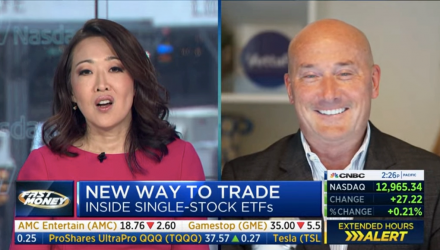Single-stock ETFs have recently become prominent when considering new ways to trade volatile stocks such as Tesla (TSLA) and NVDA. They hit the market this summer with a design to simplify shorting for active investors. VettaFi’s Vice Chairman, Tom Lydon, was on hand on CNBC’s “Fast Money” to discuss whether or not the risks outweigh the benefits.
As Lydon explains, the reasoning for having these funds is due to more optionality for individual investors and sophisticated traders who don’t necessarily want to use all of the cash they have on the sidelines. They can also go inverse, and most investors must fill out options and margins agreements to do that. This is an excellent way for them to hedge, even if it means keeping an eye on things daily.
Lydon adds, “It’s also a great way to get heading instruments from financial advisors. As the market has been really volatile, the stocks that these represent are great opportunities to pick them up off the bottom, or, if you’re not happy about them, you can buy the short side without having to do any margin.”
Essentially, these leveraged and inverse single-stock ETFs only reflect single-day moves, so long-term investors may find that the actual performance goes beyond or falls short of their intended leverage or inverse, depending on market volatility.
“If you feel like these stocks are going to go south, you can go in for a given day, and on the AXS 1.25X NVDA Bear Daily ETF (Nasdaq: NVDS), you can get that leverage to the downside, and short by using, ultimately, a long vehicle.”
Who’s up for Single-Stock Funds?
Lydon notes that these are not for the average investor, although ETFs continue to evolve and try to grab more of the marketplace. Still, these single-stock funds are aggressive in nature. They have to be traded almost daily. However, for some, they come into play because they wrap so much up into one ticker.
Regarding how well-received these ETFs are, they seem to follow other leveraged/inverse ETFs in that short-term traders quickly go in and out of these alternative ETF strategies to capitalize on market moves quickly. Consequently, total assets under management may not stand out, but overall trading volumes are very high.
When considering just buying the stock, it’s important to understand that these funds provide leverage or margin without applying for an options/margin authorization for a brokerage account. Although the U.S. Securities and Exchange Commission has opened the door for these ETFs and others to enter the market with The ETF Rule, it appears to do so with gritted teeth. They probably didn’t intend for the rule to include single-stock ETFs.
For more news, information, and strategy, visit VettaFi.com.
